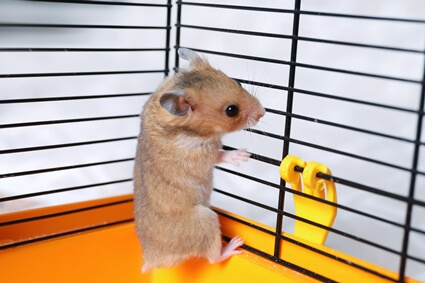Hamsters are mini escape artists. If you don’t secure their cage, they can slip through the gaps and run amok in the environment beyond. Finding them and getting them back inside the cage isn’t easy.
Hamsters attempt to escape if they feel unsafe or the opportunity arises. Stress due to boredom, a lack of hiding spaces, or a too-small cage leads to escape attempts. Hamsters have strong burrowing instincts, so if you don’t provide at least 8 inches of bedding, they’ll climb their cage to get out.
Most hamsters always want to escape, even if their setup meets their care standards. Female Syrian hamsters are the main culprits and are much harder to please than males.
Why Does My New Hamster Keep Trying To Escape?
You may find a hamster desperately trying to escape its cage. As mentioned, no matter how well you set up a hamster’s enclosure, some are naturally inclined to find their way out.
Female Syrians are likelier to do this because they’re more destructive and temperamental, while males tend to be calmer and less territorial. That said, all hamsters are at risk of escaping if they get the chance, especially when they’re unfamiliar with their surroundings.
There are several reasons why a new hamster keeps trying to escape, such as:
Cage Too Small
Hamster cages must be a certain size for hamsters to be happy. The recommended sizes are as follows:
- The Humane Society of the United States (HSUS): A wire cage measuring 576 square inches or a 24 x 12-inch aquarium measuring 288 square inches.
- American Society for the Prevention of Cruelty to Animals (ASPCA): 2000 square inches.
- Royal Society for the Prevention of Cruelty to Animals (RSPCA): As large as possible.
It’s accepted within the hamster welfare community that cages should be at least 70 x 40 cm (430 square inches) for dwarf hamsters and 80 x 50 cm (620 square inches) for Syrian hamsters.
However, a bigger enclosure enables hamsters to burrow, forage, and explore.
Animal Welfare studied several golden hamsters in different-sized cages. They found that hamsters kept in a cage of 10,000 cm2 were happiest.
If you keep a hamster in a cage that doesn’t meet these requirements, it’s more likely to try to escape.

Natural Instincts
Hamsters escape their cages because of their instinct to dig long underground tunnels. Their natural digging instincts are amplified when there’s insufficient bedding to tunnel through.
Wild hamsters dig tunnels approximately 0.7 meters deep, requiring lots of digging space to satisfy their instincts.
Similarly, some hamsters are hardwired to attempt to escape. As mentioned, female Syrians are harder to please. Your hamster may have a big cage, yet it still tries to escape.
Unfortunately, even the most enriching cages aren’t always enough to make them happy. As a result, you must focus on ensuring the hamster can’t escape rather than stop it from getting away.
Stressed Out
Hamsters are prey animals, which means they’re constantly looking for dangers. As a result, hamsters are naturally timid animals, so they’ll attempt to escape and flee if they feel unsafe.
Many things can cause stress, such as:
- Cats and other pets.
- Loud noises.
- Bright lights.
- Frequent handling (if they haven’t been tamed).
- Not enough bedding.
- Too many full-cage cleans.
Consider moving the cage or creating a quieter, darker environment for the hamster. Don’t let other animals in the hamster’s room so it doesn’t feel threatened.
Boredom
Hamsters are active animals that run for several miles and forage for food in the wild.
If they don’t have a large exercise wheel and toys, they’ll find other means of enrichment. This includes escaping to explore the wider surroundings. Some of the best forms of enrichment include:
By distracting a hamster with things it enjoys playing with inside the cage, it’ll be less inclined to escape.
Too Much Open Space
Even though hamsters need floor space, they like their enclosures to be semi-cluttered to escape danger.
If you don’t provide enough hideouts or places for the hamster to retreat to, it’ll feel threatened enough to attempt to escape its environment.
Because hamsters are prey animals, they’re constantly on high alert. Even the slightest noises can trigger their prey instincts, so they need hiding places to feel comfortable and safe.
Why Is My Hamster Climbing the Cage?
Hamsters are good at climbing and scaling their cages to explore and learn more about their environment. Hamsters in barred enclosures are likelier to climb than those with solid walls.
They also monkey bar on the roof, which can lead to injuries when the hamster loses its grip and falls.
That said, hamsters climb their cages for similar reasons to wanting to escape, most commonly due to stress or a lack of boredom breakers. As a result, this behavior also signifies an issue.
While hamsters scramble over rocks and birchwood in the wild, they aren’t natural climbers. Hamsters only experience enclosures in captivity, so they learn to climb their cages as pets.
Climbing can indicate something’s bothering the hamster.
How Do You Find a Lost Hamster?
If a hamster succeeds in its escape attempt, you’ll need to find a way to get it back. There are many methods you can try to find your pet. Take a strategic approach with the following steps:
Thorough Search
Your first step should be to look for your hamster. You might have more luck at night-time when your pet’s more likely to be active. Make sure you:
- Check underneath and behind furniture.
- Look inside cabinet drawers – even the ones at the top.
- Check underneath blankets and bedding in case the hamster’s made a nest.
- Look behind all appliances. You might need to use a torch for better visibility.
- Take a look inside any bags and backpacks.
- Check inside and behind your closet.
Lure Out with Treats
If you don’t find the hamster immediately during your search, you’ll need to use treats to lure it out.
If you use too many, a hamster will stash them in its pouch and store them in its hiding place, making it harder to locate and retrieve the hamster.
Place a couple of treats in each room to determine which one the hamster is in.
Track with Flour
A good way to track a hamster’s whereabouts is to spread a light dusting of flour across the floor. Once the hamster walks through it, you can see where it’s been and track its movements.
You can also place a layer of aluminum on the floor and wait until the hamster becomes active. You’ll be able to hear as soon as the hamster walks over it and have a chance at catching it.
Bucket Trap
The bucket trap is the best way to catch a lost hamster. To make one, you’ll need the following:
- A tall bucket.
- Books or thin boxes.
- Treats like peanut butter.
- Cucumber (for water).
- A clean tea towel.
Then you’ll need to follow these steps:
- Place the tea towel folded up in the bottom of the bucket. It needs to be thick to break your hamster’s fall.
- Put your chosen treat and a slice of cucumber on top of the tea towel.
- Stagger the books or boxes next to the bucket to create steps for the hamster to climb.
- Periodically check the bucket. You may need to be patient, but with luck, the hamster will eventually fall in, leaving you the chance to retrieve it.

How Do I Stop My Hamster From Trying To Escape?
It can be stressful to see the hamster always trying to escape. Thankfully, there are things you can do to discourage this behavior, such as:
Glass Tank
Barred cages are easier for hamsters to escape than glass tanks and aquariums. Hamsters can’t climb glass walls, so if you have an escape artist, consider upgrading your wire cage to a tank.
That way, the hamster won’t be able to get out. Ensure you provide a mesh lid with ventilation so the hamster doesn’t overheat, as glass retains more warmth than wire enclosures.
40-gallon breeder tanks from Petco work well and are relatively inexpensive. Fish tanks are another option, but you must ensure they’re not too narrow.
Hamsters need more floor space than height, which is why wider breeder tanks work best.
Exercise Wheel
Hamsters will attempt to escape if they don’t have the means to be active.
Hamsters also need large wheels to prevent spinal injuries. Many owners mistakenly provide wheels that are too small. Eventually, hamsters will stop using them because of the discomfort.
That’s why experts recommend the following wheel sizes:
| Hamster Breed | Exercise Wheel Size |
| Dwarf hamsters: | 20 cm (8 inches) in diameter |
| Chinese hamsters: | 26 cm (10 inches) in diameter |
| Syrian hamsters: | 28 cm (11 inches) in diameter |
If your wheel is too small and the hamster attempts to escape, it’s time to upgrade to a larger one.
Free Roaming
A hamster may be desperate to get outside and explore. There’s no harm in letting the hamster explore the world beyond its cage as long as you always supervise it.
You can let your hamster free roam by blocking access to small spaces. If that’s not feasible, get a large playpen and add some hideouts, a wheel, and other things for your pet to play with.
Optimizing a hamster’s environment can minimize stress, reducing the chances of escape.





